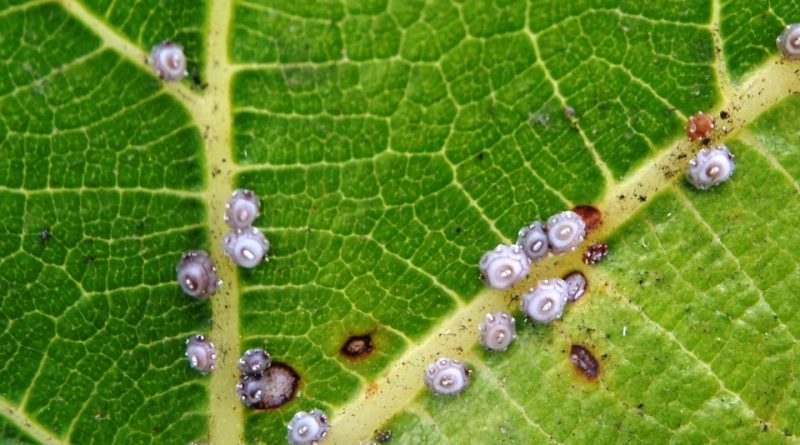Ceroplastes rusci
Ceroplastes rusci
The scale insect (Ceroplastes rusci Linnaeus, 1758) is an insect belonging to the Coccidae family.
Systematic –
From a systematic point of view it belongs to:
Eukaryota domain,
Kingdom Animalia,
Subkingdom Eumetazoa,
Bilateria branch,
Phylum Arthropoda,
Subphylum Hexapoda,
Class Insecta,
Subclass Pterygota,
Exopterygota cohort,
Subcohort Neoptera,
Superorder Paraneoptera,
Section Rhynchotoidea,
Order Rhynchota,
Suborder Homoptera,
Sternorrhyncha section,
Superfamily Coccoidea,
Coccidae family,
Genus Ceroplastes,
Species C. rusci.
The term is basionym:
– Coccus rusci Linnaeus, 1758
The terms are synonymous:
– Calypticus hydatis Signoret, 1869;
– Calypticus radiatus Costa, 1829;
– Calypticus testudineus Costa, 1829;
– Ceroplastes denudatus Cockerell, 1893;
– Ceroplastes nerii Newstead, 1897;
– Ceroplastes rusci Borg, 1919;
– Ceroplastes rusci Signoret, 1872;
– Ceroplastes tenuitectus Green, 1907;
– Chermes caricae Boisduval, 1867;
– Coccus artemisiae Rossi, 1794;
– Coccus caricae Fabricius, 1794;
– Coccus caricae Fernald, 1903;
– Coccus hydatis Costa, 1829;
– Columnea caricae Targioni Tozzetti, 1867;
– Columnea testudinata Targioni Tozzetti, 1868;
– Columnea testudiniformis Targioni Tozzetti, 1866
– Lecanium artemisiae Signoret, 1872;
– Lecanium radiatum Walker, 1852;
– Lecanium rusci Walker, 1852;
– Lecanium testudineum Walker, 1852.
Geographic Distribution and Habitat –
It is a scale insect, somewhat polyphagous, widespread in the Mediterranean basin, with detections in coastal areas ranging from Portugal (Atlantic Ocean), Spain, coastal areas of the Tyrrhenian Sea, Greece and islands, and also with presences in Japan, on the southern coasts of Australia and other small areas.
This cochineal is present on various plants and in particular on figs but also on citrus fruits, olive trees, laurel, holly, oleander, pittosporum, palms, poplars, plane trees, strawberry trees, mulberries, vines, etc. and numerous ornamental crops.
Morphology –
Ceroplastes rusci is a phytomiza mealybug in which the adult female has the body covered with nine waxy plates, of which a polygonal dorsal surrounded by eight other umbilicates.
In young females the color of the waxy shield is greyish, while in ovigenous females it is brick red.
The male follicle is white in color and elliptical-elongated in shape and is surrounded by 15 large waxy rays and two other dorsal rays.
The nymphs, on the other hand, are rusty-yellow in color and spread on the plants, colonizing the leaves.
Aptitude and biological cycle –
The Ceroplastes rusci, as mentioned, is a polyphagous insect that carries out only one generation per year even if in particular southern and insular microclimates a second generation has been ascertained.
This scale insect overwinters as a third-aged or adult nymph. The females begin oviposition (on average 1000-1500 eggs per female) in the period of April and the nymphs colonize the leaves, occupying the upper surface in the first stages and then migrating, as early as August, onto the branches to overwinter; the second generation, when present, begins in July-August.
Ecological Role –
Ceroplastes rusci is a cochineal insect mainly found in fig trees but which can affect other plants and crops.
Following the massive presence of this insect, the vegetation of the plants is smeared by honeydew and then, as always, by soot. In case of high presence the vegetation can also decay and then dry up.
Before going into the merits of the interventions to protect and fight this insect, it is underlined that this cochineal already has antagonists in nature.
Among these we remember the predators: Chilocorus bipustulatus and Exocomus quadripustulatus (Coleoptera: Coccinellidae); Eublemma scitula (Lepidoptera: Noctuidae) and parasitoids: Coccophagus flavoscutellatum (Hymenoptera Chalcidoidea Afelinidae); Scutellista cyanea (Hymenoptera: Encyrtidae) zoophagous predator but also ectophagous parasitoid of young females.
For this reason, before undertaking any control intervention, you should contact an agronomist or forestry doctor, an expert in entomology, to understand the presence of these predators and parasitoids and the actions to be taken.
Furthermore, it is always useful to implement agronomic interventions, such as winter brushing of infested branches, an operation to be carried out after pruning.
As regards phytosanitary interventions, however, there are various different formulations, containing different active substances. Most of the formulations contain mineral oil, while some are based on sweet orange essential oil or, again, active ingredients such as Cyhalothrin.
It is recommended, however, before resorting to the use of synthetic molecules, where possible and necessary, to carry out interventions with white oils where the nymphs emerge, particularly in summer.
Guido Bissanti
Sources
– Wikipedia, the free encyclopedia.
– GBIF, the Global Biodiversity Information Facility.
– Russo G., 1976. Agricultural Entomology. Special Part. Liguori Editore, Naples.
– Pollini A., 2002. Manual of applied entomology. Edagricole, Bologna.
– Tremblay E., 1997. Applied entomology. Liguori Editore, Naples.
Photo source:
– https://inaturalist-open-data.s3.amazonaws.com/photos/214105773/original.jpeg

